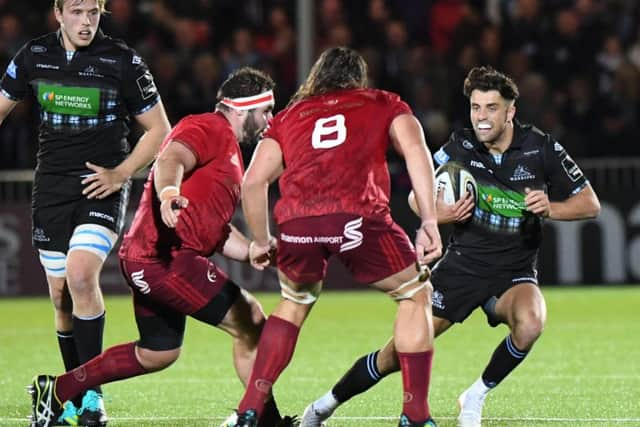Iain Morrison: Adam Hastings gives Glasgow the edge
The difference between the two teams lay in Glasgow’s backline execution which was markedly slicker in thought and deed than that of the visitors, and sitting at the centre of the operation was Adam Hastings, the youngster orchestrating play like a veteran virtuoso. He was the creative influence behind two of Glasgow’s tries, the third being a gimmie from a JJ Hanrahan error.
Hastings was involved three times in the build-up to the Warriors’ first try. He sent Peter Horne up the middle of the field before popping to Adam Ashe, another stand-out player, who returned the favour, and Hastings’ long pass fell perfectly for Callum Gibbins wide on the right.
Advertisement
Hide AdAdvertisement
Hide AdFor Glasgow’s second score, Hastings dropped the ball on to his foot and poked it in behind Munster’s rush defence where it sat up nicely for Stuart Hogg. If that sounds simple, remember the in-goal area at Scotstoun is only about five metres wide.


After looking out of sorts against Connacht in the opening game, Hastings filled his boots on Friday night but only thanks to the brutal physical assault on Munster by an energised Glasgow pack who were goaded into action by the sniping from the sidelines about their lack of intensity which has become an issue.
“Before this game we spoke about physicality,” Hastings admitted afterwards. “Where last week we probably weren’t up to it for most of the game, this week there was a huge focus on being really brutal around the contact area and I think you saw that all the forwards were outstanding. Playing behind them was amazing.
“A lot of teams think we just play flamboyant, chuck-it-wide rugby but against Munster we showed we can truck it up and be physical around the contact area. That was really good for us.”
The fact that Munster had called upon five substitutes before Glasgow went to their bench says all you need to know about the intensity of the collisions.
The first half will give Glasgow confidence going forward, although Munster were missing a handful of big beasts – think Peter O’Mahony, CJ Stander and Keith Earls – easing their way back into the system in line with Irish Rugby’s protocols.
Munster coach Johann van Graan made this very point after the game. All but two of Glasgow’s starting XV were Test players, but they too have a few bodies still to call upon. Brian Alainu’uese will surely be more use in the second row than as a blind-side flanker, which is Rob Harley’s day job.
And Alex Dunbar’s demotion to the bench puzzles everyone except those that make the decisions. He maybe lacks Peter Horne’s communication skills but Dunbar offers front-foot ball and he doesn’t miss anywhere near the number of tackles of his rival.
Advertisement
Hide AdAdvertisement
Hide AdIncidentally, Glasgow will be sweating on the availability of Gibbins for the next few matches. The Kiwi flanker was involved in a first-half collision at a breakdown with Munster’s Neil Cronin that resulted in the visiting scrummy leaving the field nursing his shoulder. The TMO could not find any incriminating evidence at the time but Van Graan was unhappy.
“I thought there were quite a few big moments in the game,” said the Munster coach. “I thought the incident here, right under the sticks in the first half that was referred [to the TMO] was a big turning point in this game because the numerical numbers could have been a lot different for the rest of the game.”
He answered in the positive when asked if there should have been a card, and his point about numbers for “the rest of the game” strongly suggests that the South African thinks it should have been red.
Van Graan went on to say that he had not spoken to the referee but would follow “the right channels”. Coaches can’t cite but they can highlight incidents that they think warrant further attention.